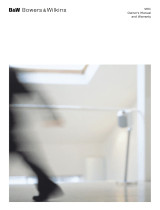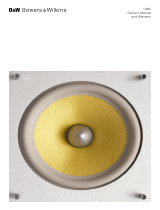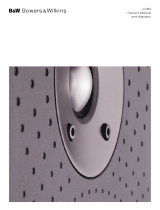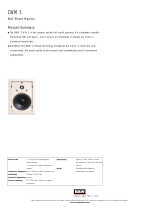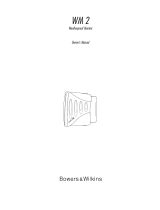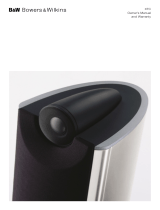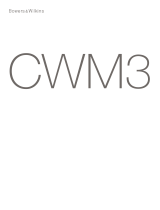
Custom Installation Series
CWM DS8
Owner’s Manual
and Warranty
Page is loading ...
Page is loading ...
Page is loading ...

2
English
Limited Warranty
Dear customer, welcome to B&W.
This product has been designed and
manufactured to the highest quality
standards. However, if something does go
wrong with this product, B&W
Loudspeakers and its national distributors
warrant free of charge labour (exclusion
may apply) and replacement parts in any
country served by an official B&W
distributor.
This limited warranty is valid for a period of
five years from the date of purchase or two
years for electronics including amplified
loudspeakers.
Terms and Conditions
1 The warranty is limited to the repair of
the equipment. Neither transportation,
nor any other costs, nor any risk for
removal, transportation and installation
of products is covered by this warranty.
2 This warranty is only valid for the
original owner. It is not transferable.
3 This warranty will not be applicable in
cases other than defects in materials
and/or workmanship at the time of
purchase and will not be applicable:
a. for damages caused by incorrect
installation, connection or packing,
b. for damages caused by any use other
than correct use described in the user
manual, negligence, modifications, or
use of parts that are not made or
authorised by B&W,
c. for damages caused by faulty or
unsuitable ancillary equipment,
d. for damages caused by accidents,
lightning, water, fire heat, war, public
disturbances or any other cause
beyond the reasonable control of B&W
and its appointed distributors,
e. for products whose serial number has
been altered, deleted, removed or
made illegible,
f. if repairs or modifications have been
executed by an unauthorised person.
4 This guarantee complements any
national/regional law obligations of
dealers or national distributors and
does not affect your statutory rights as
a customer.
How to claim repairs under
warranty
Should service be required, please follow
the following procedure:
1 If the equipment is being used in the
country of purchase, you should
contact the B&W authorised dealer
from whom the equipment was
purchased.
2 If the equipment is being used outside
the country of purchase, you should
contact B&W national distributor in the
country of residence who will advise
where the equipment can be serviced.
You can call B&W in the UK or visit our
web site to get the contact details of
your local distributor.
To validate your warranty, you will need to
produce this warranty booklet completed
and stamped by your dealer on the date of
purchase. Alternatively, you will need the
original sales invoice or other proof of
ownership and date of purchase.
Owner’s manual
Introduction
Thank you for purchasing Bowers and
Wilkins CWM speakers.
Since its foundation in 1966, the continuing
philosophy of B&W has been the quest for
perfect sound reproduction. Inspired by the
company’s founder, the late John Bowers,
this quest has entailed not only high
investment in audio technology and
innovation but also an abiding appreciation
of music and movies to ensure that the
technology is put to maximum effect.
These CWM speakers are primarily
intended for in-wall applications, but may
equally well be used in-ceiling.
However, no matter how good the speakers
themselves, they will not deliver their full
potential unless properly installed. Please
read through this manual fully. It will help
you optimise the performance of the
system.
B&W distributes to over 60 countries
worldwide and maintains a network of
dedicated distributors who will be able to
help should you have any problems your
dealer cannot resolve.
Check the contents
This pack should contain:
• wall frame
• baffle with drive units and crossover
• grille with backing scrim fabric
• paint mask
• mounting template
• 6x M6 screw
Choosing the position
Check that there is no conflict with other
installations (pipe work, air conditioning,
power cabling etc.). In existing drywall
construction, use a stud-finding tool to
map the construction accurately and a pipe
detector to scan the proposed installation
position.
Refer to the section drawing of the speaker
and ensure that there is enough clearance
behind the plasterboard (sheetrock) for the
clamps to swing out fully.
Avoid installing the speakers in the same
cavity as flimsy ducting, which may be
induced to rattle.
The speakers are designed to operate
satisfactorily in a wide range of cavity
volumes, ideally above 20 litres (0.7 cu ft),
so make sure the volume is not too
restricted by cross studs.
In solid wall construction, be prepared to
provide a cavity in the wall that extends
outside the boundaries of the speaker’s
frame, otherwise bass performance will be
compromised.
The speakers are balanced for half-space
mounting (ie flush in a wall or ceiling).
Placement near a wall/ceiling junction or in
a corner may give rise to too much bass
and a boomy quality to the sound. Try to
keep the speakers at least 0.5m (20in) from
wall/ceiling edges.
The following sections give guidance on
optimum positioning, but this may be
modified in line with domestic constraints.
WARNING: The speakers produce a static
magnetic field. They should not be placed
within 0.5m (20in) of equipment that may
be affected by such a field (eg Cathode
Ray Tubes in TVs and Personal
Computers).
Surround speakers
The speakers should be positioned 60cm
(2 ft) or more above head height.
5.1 channel
If it is desired to use both dipole and
monopole modes, the horizontal angle to
the centre of the listening position should
be approximately 120º round from the
centre of the screen. (figure 1)
If only dipole mode is required, position the
speakers in line with the centre of the
listening area. (figure 2)
6.1 channel
Position two speakers to the sides in line
with the centre of the listening area and
one centrally behind the listeners (figure 3)
7.1 channel
Position two speakers to the sides in line
with the centre of the listening area and
two behind the listeners, subtending an
angle of approximately 40º. (figure 4)
PREPARING THE LOCATION
Choosing cable
Excessive resistance in the speaker cable
wastes power and alters the frequency
response of the speaker. Always try to keep
the resistance as low as possible with the
loop resistance preferably below 0.5 ohms
for non-critical applications and below
0.2 ohms for best results. Use the table of
figure 14 to calculate the minimum gauge
of cable required.
If remote switching between monopole and
dipole modes is required, an extra 2-core
cable is needed for the 12V trigger. At the
speaker end, strip back the insulation to
leave bare wire ends. It is usual for the 12V
trigger output of a processor to take a
3.5mm jack plug.
Existing drywall construction
(retrofit)
Position the template at the desired
location of the speaker. The template is
marked with both vertical and horizontal
centre lines to aid alignment.

3
Trace round the outer edge of the template
and cut neatly just inside the line.
To improve the mechanical integrity of the
wall and reduce the likelihood of rattles, we
recommend you apply a bead of wood glue
or mastic along the joints between the back
of the plasterboard and the studs in the
vicinity if the speaker.
Run the cable to the aperture, allowing
enough length to comfortably connect the
speaker, but not too much, as the excess
may rattle against the structure.
New drywall construction
The speaker can be installed once the wall
is completed in the same manner as
retrofitting, but it is easier to position and
cut the hole if the optional pre-mount kit is
used before the plasterboard (sheetrock) is
fitted.
Staple or nail the PMK to the studs as
described in the instructions with the kit.
Run the cable and secure it to the fixing
point on the PMK. Allow enough length to
comfortably connect the speaker, but not
too much, as the excess may rattle against
the structure.
Results are affected by how well the
plasterboard is attached to the studs and
we recommend gluing as well as screwing
or nailing the panels to the studs in the
vicinity of the speaker.
Once the board is fitted, the inner flange of
the PMK serves as a guide for a hole router
or saw.
If extra acoustic isolation to adjoining
rooms is required or some protection
against the spread of fire, use the optional
back box in place of the PMK. Follow the
instructions with the back box for fitting
and running the cable.
When fitting the plasterboard, use mastic
between the sheets and the back box to
avoid rattles. Rout or saw out the speaker
aperture using the backbox flange as a
guide. Depending on the diameter of the
router, you may need to square off the
corners with a saw.
Solid wall construction
In order for the bass performance not to be
compromised, the speaker requires a cavity
volume of at least 20 litres (0.7 cu ft). This
means that, in a standard 10cm (4 in) thick
wall, the cavity will extend beyond the
boundaries of the speaker frame. It is
possible to provide this cavity simply by using
a lintel, covering the hole with plasterboard
and fitting the speaker as described above for
retrofitting into a drywall. (figure 5) However,
the back box provides a useful means of
defining the minimum volume required.
Follow the instructions with the back box for
fitting and running the cable. If using a wet
plaster finishing method, first paint a layer of
PVA adhesive onto the back box before
plastering to avoid rattles as a result of the
plaster shrinking away from the back box as
it dries.
If using plasterboard, stick the sheets to the
surfaces of the back box using flexible
mastic. Rout out the aperture using the
flange as a guide. Depending on the
diameter of the router, you may need to
square off the corners with a saw.
In all cases, we recommend not using
cement or mortar to fix the back box into
the brick or blockwork. rattles are best
avoided by using flexible mastic and
wedges. (figure 6)
Damping the cavity
Fill the wall cavity or back box, but not the
space immediately behind the speaker, with
unlined fibreglass or mineral wool matting.
The packing density should be just enough
to comfortably prevent the material from
dropping or sagging over time. In an open
wall cavity, fill to a distance of at least
30cm (1 ft) above and below the speaker.
(figure 7)
In the ceiling, drape the matting at the back
of the ceiling board, covering the aperture
and extending at least 30cm (1 ft) around
the speaker into open void. (figure 8)
IMPORTANT: Ensure that the materials you
use meet local fire and safety regulations.
Fitting the speaker
All connections should be made with the
equipment switched off.
With the grille removed, position the wall
frame in the aperture and screw in the
6 screws visible from the front. (figure 9)
These screws automatically swing out
clamping dogs that locate behind the
mounting surface. Ensure that they have
located properly before fully tightening the
screws. A certain amount of flexing of the
frame is allowed to take up unevenness in
the mounting surface, but do not
overtighten the screws as excessive
distortion of the speaker frame may result.
If required, the wall frame and grille mesh
should be painted at this stage, before
fitting the baffle. See also the section
“Customising” below.
Connect the signal cable to the gold plated
spring loaded input terminals on the
crossover and the trigger cable, if used, to
the plastic spring terminals. Ensure the
correct polarity is observed in both cases.
(figure 10)
There are 2 switches on the crossover. One
is marked ‘dipole’ and ‘monopole’. In the
‘dipole’ position, the speaker is in dipole
mode, whatever the status of the 12V
trigger. In the ‘monopole’ position, the
speaker is in monopole mode unless 12V is
applied to the trigger input, when the
speaker becomes dipole.
The second switch is marked ‘A’ and ‘B’.
When viewed from the front, the positive
dipole lobe goes to the right of the speaker
when the switch is at ‘A’ and to the left
when the switch is at ‘B’. (figure 11). Set
the lobes as shown in figure 12, according
to the position of the speaker.
Fit the baffle into the wall frame using the 6
screws provided. (figure 13)
Fit the grille mesh. If the slot width has
become distorted by overtightening the wall
frame clamps, it will be necessary to
remove the baffle, loosen the clamps and
re-tighten them more evenly.
Fine tuning
The choice of monopole or dipole mode
may depend on the type of programme
being played, the speaker’s position in the
installation and, of course, personal
preference.
Multi-channel music often has more
directional cues in the surround sound field
and it may be preferable to have all the
speakers set to monopole. Movie sound is
usually more convincing with a diffuse
sound field and it is usual to set at least the
side speakers to dipole. Rear speakers in
6.1 and 7.1 installations are sometimes set
to monopole, even if the side speakers are
set to dipole, but dipole all round is also an
option. Experiment to find the best settings
for your situation.
The 12V trigger option may be used to
automatically set different modes for
different types of programme. Some
processors can detect whether the
programme being played is music or movie
and assign a trigger accordingly. Some
others can assign a trigger to the input
socket being used and you may wish to
use a different player for music than that
used for movies.
Customising
The frame has a paintable white semi-matte
finish, ready if necessary to be re-finished
to match your own decor. If you do not
wish to remove the speaker baffle, fit the
paint mask before re-finishing. Do not
re-finish the drive units or baffle area
behind the grille. Avoid touching the drive
units, as damage may result.
Before painting the grille, peel off the fabric
scrim from the back, otherwise the pores
will get clogged and the sound will be
impaired. If the scrim does not stay in place
properly when replaced, spray the back of
the grille mesh (NOT the scrim) with a light
coating of 3M SprayMount adhesive or
similar.
Page is loading ...
Page is loading ...
Page is loading ...
Page is loading ...
Page is loading ...
Page is loading ...
Page is loading ...
Page is loading ...
Page is loading ...
Page is loading ...
Page is loading ...
Page is loading ...
Page is loading ...
Page is loading ...
Page is loading ...
Page is loading ...
Page is loading ...
Page is loading ...
Page is loading ...
Page is loading ...
Page is loading ...
Page is loading ...
Page is loading ...
Page is loading ...
Page is loading ...
Page is loading ...
Page is loading ...
Page is loading ...
Page is loading ...
Page is loading ...
Page is loading ...
Page is loading ...

36
CWM DS8
Technical features
Description
Drive units
Frequency range
Frequency response (±3dB)
Sensitivity
Nominal impedance
Crossover frequency
Maximum amplifier power
Cut-out size
Weight
Woven Kevlar
®
bass/midrange driver
Nautilus
™
tube-loaded tweeter
3-way dipole/2-way monopole in-wall system
ø180mm (7 in) Kevlar
®
cone bass/midrange
2x ø80mm (3 in) Kevlar
®
cone midrange
3x ø25mm (1 in) Nautilus
™
tube loaded aluminium dome tweeter
-6dB at 40Hz and 50kHz (monopole)
-6dB at 40Hz and 18kHz (dipole)
45Hz - 22kHz (monopole) on reference axis
45Hz - 15kHz (dipole) on reference axis
88dB spl (2.83V, 1m)
8
Ω
(minimum 3.3
Ω
)
3.5kHz (monopole)
250Hz, 4kHz (dipole)
150W continuous into 8
Ω
on unclipped programme
H 485mm (19.1 in) W 255mm (10 in)
5.7kg (12.5 lb)

Copyright © B&W Group Ltd. E & OE
Kevlar is a registered trademark of DuPont
Nautilus is a trademark of B&W Group Ltd.
Printed in England.
B&W Group (UK Sales)
T +44 1903 221 500
B&W Group North America
T +1 978 664 2870
B&W Group Asia Ltd
T +852 2 869 9916
B&W Group Ltd
Dale Road
Worthing West Sussex
BN11 2BH England
T +44 (0) 1903 221 800
F +44 (0) 1903 221 801
www.bwspeakers.com
ll09990 Issue 1
/
